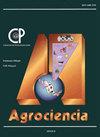阿拉比卡咖啡母株的田间植物保护、消毒和胼胝质形成诱导
IF 0.5
4区 农林科学
Q4 AGRICULTURE, MULTIDISCIPLINARY
引用次数: 0
摘要
在墨西哥的恰帕斯,有适应当地气候条件的高产咖啡树。外植体中微生物的存在使得在体外克隆这些基因型的方案很难制定。本研究的目的是评价田间和体外微生物管理如何影响具有重要农艺意义的咖啡植物叶片外植体的无菌性和诱导胼胝质形成。通过参与性研究、农艺和体外技术,从无菌外植体和细胞培养中获得耐旱基因型。从21岁波旁品种选育5份材料(ITTGj 1 ~ 5)。本研究通过两个开花周期进行,评估田间管理对第一个开花周期外植体无菌的影响,以及培养基、运输溶液和基因型对第二个开花周期的胼胝质形成反应。在外植体采集前60天,每两周使用一次聚硫化钙(10% v v-1)、氯化氧化铜(2g L-1)和生姜提取物(20g L-1),真菌污染减少100%,细菌污染减少90%。外植体在200mg L-1柠檬酸和抗坏血酸溶液中运输可减少外植体和离体培养中的氧化。4.4µM BAP(6-苄基氨基嘌氨酸)和7.25µM 2,4-d(2,4-二氯苯氧乙酸)在培养45 d时形成前胚性脆性玉米,其中基因4型反应最佳。田间管理对体外无菌培养的阿拉比卡咖啡是有效的,BAP和2,4- d联合使用是一种合适的生长调节剂,可以诱导其形成callogenesis。本文章由计算机程序翻译,如有差异,请以英文原文为准。
FIELD PHYTOPROTECTION OF Coffea arabica MOTHER PLANTS, DISINFECTION AND CALLOGENESIS INDUCTION
In Chiapas, Mexico, there are high-yielding coffee plants adapted to the local climatic conditions. The presence of microorganisms in the explants makes developing protocols for cloning these genotypes in vitro difficult. The objective of this work was to evaluate how field and in vitro microorganism management affected asepsis and the induction of callogenesis in leaf explants of agronomically important coffee plants. Drought-tolerant genotypes were obtained from aseptic explants and cell cultures using a participatory study, agronomic, and in vitro techniques. Five accessions (ITTGj 1-5) were selected from a 21-year-old Borbon cultivar. The present study was conducted over two flowering cycles, evaluating the effect of field management on explant asepsis on the first and the callogenic response caused by the culture medium, the transport solution, and the genotype, on the second. Sixty days before explant collection, biweekly applications of calcium polysulfide (10 % v v-1), copper oxychloride (2 g L-1), and Zingiber officinale extract (20 g L-1) reduced fungal contamination by 100 % and bacterial contamination by 90 %. Field explant transportation in 200 mg L-1 citric acid and ascorbic acid solution reduced oxidation in explants and in vitro cultures. Proembryogenic friable corns were formed with the combination of 4.4 µM BAP (6-benzylaminopurine) and 7.25 µM 2,4-D (2,4-dichlorophenoxyacetic acid) at 45 days of culture, with genotype four showing the best response. Field management was effective for the aseptic establishment of Coffea arabica cultures in vitro, and the combination of BAP and 2,4-D used was an appropriate growth regulator for the induction of callogenesis.
求助全文
通过发布文献求助,成功后即可免费获取论文全文。
去求助
来源期刊

Agrociencia
农林科学-农业综合
CiteScore
0.50
自引率
33.30%
发文量
51
审稿时长
18-36 weeks
期刊介绍:
AGROCIENCIA is a scientific journal created and sponsored by the Colegio de Postgraduados. Its main objective is the publication and diffusion of agricultural, animal and forestry sciences research results from mexican and foreign scientists. All contributions are peer reviewed. Starting in the year 2000, AGROCIENCIA became a bimonthly and fully bilingual journal (Spanish and English versions in the same issue). Since 2007 appears every month and a half (eight issues per year). In addition to the printed issues, the full content is available in electronic format.
 求助内容:
求助内容: 应助结果提醒方式:
应助结果提醒方式:


